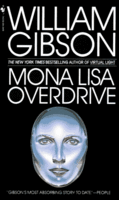 Mona Lisa Overdrive is the last in the sprawl trinity that made William Gibson famous. It follows Neuromancer and Count Zero. Like his other novels it plays with reality and virtual reality or “cyberspace” (the word Gibson coined.) The title character is vintage Gibson, a smart street girl who is picked up and altered to look like a star so that her body can be used in a kidnapping. In the end Mona Lisa replaces the star when she goes virtual (into the aleph, a biochip holding the/a world) and then takes off to meet another distant alien AI she might marry(?). It is a very old form of swapped reality, the peasant and king trading places. There are other ways Gibson plays with the varieties of altered reality. One character, the young daughter of a Japanese ganster, has a digital ghost only she can see who comforts and advises her. Another character builds robotic sculpture to exorcise his penal ghosts. Gibson is reminding of all the virtualities, including that enigmatic painted smile by Leonardo.
Mona Lisa Overdrive is the last in the sprawl trinity that made William Gibson famous. It follows Neuromancer and Count Zero. Like his other novels it plays with reality and virtual reality or “cyberspace” (the word Gibson coined.) The title character is vintage Gibson, a smart street girl who is picked up and altered to look like a star so that her body can be used in a kidnapping. In the end Mona Lisa replaces the star when she goes virtual (into the aleph, a biochip holding the/a world) and then takes off to meet another distant alien AI she might marry(?). It is a very old form of swapped reality, the peasant and king trading places. There are other ways Gibson plays with the varieties of altered reality. One character, the young daughter of a Japanese ganster, has a digital ghost only she can see who comforts and advises her. Another character builds robotic sculpture to exorcise his penal ghosts. Gibson is reminding of all the virtualities, including that enigmatic painted smile by Leonardo.
Continue reading Gibson: Mona Lisa Overdrive
Category: Science Fiction
Victor Pelevin: Omon Ra
“I wonder if anyone who sees a photograph of the moon-walker in the newspapers will imagine that inside this steel saucepan, which exists for the sole purpose of crawling seventy kilometres across the moon and then halting for eternity, there is a human being gazing out through two glass lenses? But what does it matter?” (p. 69)
Omon Ra by Russian author, Victor Pelevin is a dark science fiction novel about a young Russian who wants to be a cosmonaut and discovers that the Russian space program is a sham and that supposedly automated moon exploration robots actually have young men like him in them (who never come back.) And there’s more. I’m not sure if it is science fiction or surreal anti-science fiction.
I found the full text of a different translation into English at Lib.ru, see Victor Pelevin. Omon Ra. There is a menu which lets you get a text file version.
Continue reading Victor Pelevin: Omon Ra
